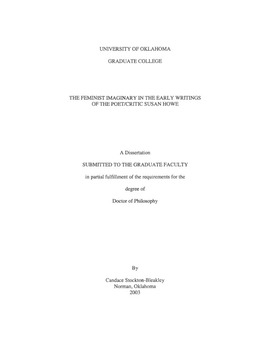| dc.contributor.advisor | Davis, R. C., | en_US |
| dc.contributor.author | Stockton-bleakley, Candace Jo. | en_US |
| dc.date.accessioned | 2013-08-16T12:19:00Z | |
| dc.date.available | 2013-08-16T12:19:00Z | |
| dc.date.issued | 2003 | en_US |
| dc.identifier.uri | https://hdl.handle.net/11244/621 | |
| dc.description.abstract | Susan Howe's early work---the poetry collected in Frame Structures, Europe of Trusts, and My Emily Dickinson, reveals the emergence of a feminist imaginary. The feminist imaginary is writing which participates in the rupture of conventional textual meaning that creates fissures and gaps and competing narratives through its disruption of syntax, the erasing or displacing of text, or the orality and sensuality, the poetic qualities of the language itself. The feminist imaginary adds a Kristevan "semiotic" dimension which transforms language and makes it dynamic and restless, charged with multiple meanings and many possible readings. These "endless protean linkages" are manifested quite often in language that is charged poetically and orally. The feminist imaginary is also writing that is able to encode discourses that are oppositional to the dominant discourses of our culture. | en_US |
| dc.description.abstract | Howe's writing is complex and challenging. Much of it is surreal and much of it implodes the very structures of language that play around sound, and meaning, and chaos. Her poetry questions the politics of identity and the way women and others can be colonized and marginalized through language. One can "follow the O" in her work---that insistent, lyrical, sparkle which manifests the semiotic, and in doing so, creates a poetry of "earth" or a poetry of immanence that is fully imbued with the feminist imaginary. | en_US |
| dc.description.abstract | Howe's poetic project prospers with the deployment of a feminist imaginary and it is also very important in her earlier work as well as in Eikon . I have attempted to read the books included in Frame Structures to show Howe's use of the feminist imaginary in Hinge Picture, Chanting at the Crystal Sea, Cabbage Gardens, and Secret History of the Dividing Line. Hinge Picture manifests the feminist imaginary by deconstructing the paratext Decline and Fall of the Roman Empire, upon which it is based. It is a polysemous text whose surreal technique exposes the violence done to "other voices" by a reified or traditional text. Howe's Dada-like technique is very much like Duchamp's original Hinge Picture. Next, I delved into the mysterious and enigmatic poetry of Chanting at the Crystal Sea and Cabbage Gardens. These poems require a kind of jouissance. Each poem is a "text of bliss, " through which the poet exposes the chaos and violence of human history and its beauty and mystery. The last book in the anthology is Secret History of the Dividing Line. This is another polysemous work that actually incorporates more and more radical dislocation of words and their placement on the page. The Europe of Trusts focuses on being feminine in a masculine world. | en_US |
| dc.format.extent | vi, 185 leaves ; | en_US |
| dc.subject | Feminism and literature. | en_US |
| dc.subject | Howe, Susan, 1937- Criticism and interpretation. | en_US |
| dc.subject | Women and literature. | en_US |
| dc.subject | Women's Studies. | en_US |
| dc.subject | Feminism in literature. | en_US |
| dc.subject | Literature, American. | en_US |
| dc.title | The feminist imaginary in the early writings of the poet/critic Susan Howe. | en_US |
| dc.type | Thesis | en_US |
| dc.thesis.degree | Ph.D. | en_US |
| dc.thesis.degreeDiscipline | Department of English | en_US |
| dc.note | Adviser: R. C. Davis. | en_US |
| dc.note | Source: Dissertation Abstracts International, Volume: 64-06, Section: A, page: 2087. | en_US |
| ou.identifier | (UMI)AAI3094292 | en_US |
| ou.group | College of Arts and Sciences::Department of English | |
